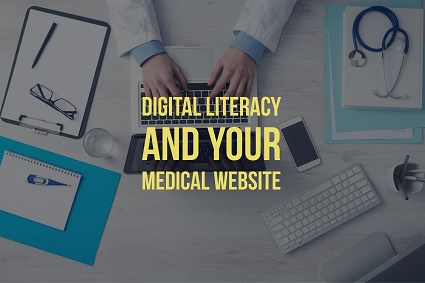Your cart is currently empty!

Digital Literacy and Medical Websites
The University of Illinois came up with a definition for digital literacy in 2014:
- The ability to use digital technology, communication tools or networks to locate, evaluate, use and create information.
- The ability to understand and use information in multiple formats from a wide range of sources when it is presented via computers.
- A person’s ability to perform tasks effectively in a digital environment.
We have a wealth of information readily available to us these days, but that information is useless if you can’t access it. Digital literacy is a skill that everyone should practice, but some sites — such as medical websites — must be accessible to people regardless of their ability to use digital information.
The new divide on digital literacy
In the past, the notion of a digital dived — the gap between those who use the internet and those who do not — focused on access. Having a computer in the home and access to high-speed internet service was the crux of the challenge.
Now, with the increasing use of smartphones as a primary digital device, access is less of an issue. The Pew Research Center found last year that 81% of American adults use a smartphone. This is a significant increase from the 35% of U.S. adults who used a smartphone in 2011. The number of American adults who own a desktop computer or laptop has hovered around 75% since 2008.
But only 17%, still according to the Pew Research Center, are “digitally ready.” That means that only a small percentage of those who own digital devices and have internet connections are actually able to use those devices to get information when they need it.
The Pew Center identified another segment of digital learners who can confidently use the internet but who are not comfortable with online learning. Together, these two groups still make up less than half the nation’s adults. These are mostly people in their 30s and 40s, with a fairly high degree of education.
The remaining 52% of the people in the Pew study are described as “hesitant.” They include people who have sufficient digital skill to use the internet for learning but choose not to, and 14% who can’t use digital tools effectively. This group includes more women, more members of ethnic minorities, more people 50 and older, and more low-income people with less formal education.
How does this relate to your medical website?
Most doctors’ patient population includes some of the hesitant — the less digitally literate — described by the Pew Center. Practically everyone who uses the internet looks for medical information online, in some way.
Those with a low level of digital literacy may have a different experience from the digitally literate. People who are less confident or less skilled in navigating online information may
- have trouble finding the information they need.
- have more trouble understanding the information they find.
- be more likely to believe misinformation.
- rely more heavily on social media and advertising.
- find it hard to judge the credibility of different information sources.
NIH guidelines suggest that patient education information be written at the 7th or 8th grade level. This recommendation is largely ignored at medical websites, including patient education pages.
Add this to the relatively low level of digital literacy in some patient populations, and the result can be serious frustration for patients and providers alike.
What can you do to help?
First, make sure you have the information your patients need at your website. You may feel that this information is readily available, but for some of your patients, it isn’t. Providing a direct link through text or email can make reliable health information available to them in a way it otherwise would not be.
Consider accessibility for your website:
- Your website must be easy to navigate.
- Be sure that your site is mobile-friendly and responsive.
- The main text on a page must be easy to identify and easy to read.
- Since older patients are statistically more likely to have limited digital literacy, you should also be sure that you have a high level of contrast between text and background.
- Your website’s font must be very readable.
- Make sure that buttons and text links are very obvious and easy to use.
- Link to reliable sources online.
- Include information about controversial subjects or those that may have a lot of misinformation online.
Since you see your patients, you can also help them increase their digital literacy:
- Offer help with finding and using your website.
- Print out pages you want them to have and show them where they can find and print those pages themselves.
- Offer essentials, like patient forms, both as web pages and as downloadable PDFs when possible.
- Encourage staff to help patients use Google Translate — make sure your team knows how!
- Share useful links in your social media and encourage patients to follow your feeds.
Now is a great time to take action on your patients’ behalf. Haden Interactive can help you do that. We offer a full range of SEO services for medical professionals. Contact us online or call 479.966.9761 and talk with Rosie today.
by
Tags:

Leave a Reply